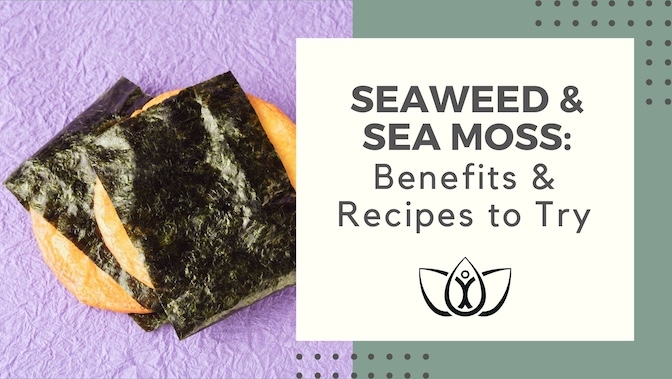.png) Seaweed, sea moss, and marine superfoods have been staples in various cultures for centuries. They continue to gain popularity worldwide for their impressive health and wellness benefits. Rich in nutrients and bioactive compounds, these ocean vegetables provide a range of benefits for the body and mind.
Seaweed, sea moss, and marine superfoods have been staples in various cultures for centuries. They continue to gain popularity worldwide for their impressive health and wellness benefits. Rich in nutrients and bioactive compounds, these ocean vegetables provide a range of benefits for the body and mind.What Are Seaweed and Sea Moss?
Seaweed refers to various species of marine algae and plants found in oceans, rivers, and lakes. Common types include nori, kelp, wakame, and dulse. Sea moss, also known as Irish moss (Chondrus crispus), is a specific type of red algae primarily harvested from the Atlantic coasts of Europe and North America. Both are consumed for their dense nutritional value and versatile culinary uses.Nutrient Profile
Seaweed (such as nori, kelp, wakame, and dulse) and sea moss are rich in vital nutrients, including:- Iodine: Essential for healthy thyroid function.
- Calcium: Important for bone health.
- Iron: Helps in the formation of red blood cells.
- Magnesium: Supports muscle and nerve function.
- Zinc: Aids the immune system and wound healing.
- Vitamin C and A: Potent antioxidants that support skin and immune health.
- Omega-3 fatty acids: Promote heart and brain health.
- Dietary fiber: Encourages digestive health and satiety.
- B Vitamins: Vital for energy production and metabolic function.
- Potassium: Helps regulate blood pressure and fluid balance.
Health Benefits
1. Supports Thyroid Health: Due to its iodine content, both seaweed and sea moss can help regulate thyroid hormones and deter conditions like hypothyroidism and goiter.2. Improves Gut Health: Rich in fiber and prebiotics, these sea vegetables support a healthy gut microbiome, promote regularity, and may reduce symptoms of bloating and indigestion.
3. Boosts Immunity: Its high antioxidant and mineral content helps strengthen immune function and protect against environmental stressors.
4. Enhances Skin Health: Sea moss is often used topically and orally for its hydrating and anti-inflammatory properties. It can help with conditions such as eczema, psoriasis, and acne.
5. Promotes Heart Health: Omega-3s and fiber contribute to reduced cholesterol levels, lower blood pressure, and improved circulation.
6. Aids Weight Management: Low in calories but high in nutrients and fiber, seaweed and sea moss can help control appetite, reduce cravings, and promote metabolic health.
7. Improves Joint and Muscle Function: Due to its anti-inflammatory properties and magnesium content, sea moss may help ease joint pain and support post-exercise recovery.
8. Enhances Mental Clarity: The omega-3 fatty acids and B vitamins found in seaweed can contribute to improved cognitive function, focus, and mood stabilization.
How to Incorporate Seaweed Into Your Diet
Seaweed salad is a delicious dish made from various types of edible seaweed, typically flavored with sesame oil, vinegar, and soy sauce. Popular in Asian cuisines, especially Japanese and Korean, it’s often served as a side dish and is appreciated for its light, refreshing taste. Read on to discover simple recipes to make this flavorful side, plus other seaweed and sea moss recipes.1. Sea Moss Gel
- Soak raw sea moss in spring water for 12-24 hours.
- Rinse thoroughly and blend with fresh spring water until smooth.
- Store in a jar and refrigerate. Use 1-2 tablespoons daily in smoothies, teas, or soups.
- Rehydrate wakame seaweed in warm water for 5-10 minutes.
- Toss with sesame oil, rice vinegar, soy sauce, grated ginger, and sesame seeds.
- Add sliced cucumbers or shredded carrots for extra crunch.
- Serve chilled as a side dish or light lunch.
- 1 cup almond milk
- 1 banana
- ½ cup spinach
- 1 tbsp sea moss gel
- 1 tsp honey or maple syrup
- ½ cup frozen pineapple or mango (optional)
- Blend until smooth and enjoy as a nutrient-rich breakfast or snack.
- Simmer kombu or kelp in water with garlic, onions, miso paste, tofu, and shiitake mushrooms.
- Add sea moss gel for added texture and nutrition.
- Garnish with green onions and a dash of soy sauce.
Selecting Your Seaweed
Wakame, nori, and dulse are popular seaweeds used in salads. Wakame is soft and mild, often in soups or salads. Nori is thin and typically used for sushi, but it also adds flavor to salads. Dulse is chewy with a salty taste. For the best quality seaweed, opt for fresh or dried options with bright colors. If you’re selecting fresh seaweed, carefully examine the seaweed to ensure no mold is present. Fresh seaweed can be found at local markets, while dried seaweed is available online or in health food stores.Add Fresh Ingredients
To enhance the flavor and nutritional value of seaweed salad, consider adding vegetables such as cucumbers, carrots, and bell peppers or fruits like mango or oranges, along with protein sources like tofu, edamame, or grilled chicken. For garnishes, try crunchy sesame seeds, herbs, or thinly sliced radishes to complement the texture and flavor of the seaweed. Those components enrich the taste and nutritional content of your salad.Dress It Up
Here are a few short dressing ideas for seaweed salads:- For vinaigrette dressing, mix 3 tbsp olive oil, 1 tbsp rice vinegar, 1 tsp honey or mustard, and a pinch of salt. Add sweetness and tang to taste.
- For sesame oil dressing, combine 2 tbsp sesame oil, 1 tbsp soy sauce, 1 tbsp rice vinegar, 1 tsp sugar, and sesame seeds. Modify the sugar amounts for sweetness.
- For a spicy chili dressing, mix 1 tbsp sesame oil, 1 tsp chili paste, 1 tsp soy sauce, 1 tsp rice vinegar, and 1 tsp lime juice. Add extra chili for more spice. Adjust the salty, sweet, and tangy components to find the proper balance for your dressing.
Make It a Meal
For optimal results, combine seaweed and sea moss with a balanced diet that includes whole grains, fruits, vegetables, and lean proteins. Variety ensures your body receives the full spectrum of nutrients it needs to thrive. Add protein sources like tofu, shrimp, or chicken to make your seaweed salad into a complete meal. It also pairs well with rice or rice noodles, offering a balanced meal perfect for a quick and healthy lunch or dinner.Health Warnings and Considerations
While seaweed and sea moss are nutrient-dense, moderation is key. Carefully review the following health warnings and considerations:- Iodine Overload: Excessive consumption can lead to thyroid dysfunction, such as hyperthyroidism. Stick to recommended serving sizes, especially if you have a thyroid condition. Speak with your healthcare provider for further guidance.
- Heavy Metals: As sea plants can absorb environmental toxins like arsenic, mercury, and lead, it’s essential to source products from reputable suppliers with third-party testing.
- Allergic Reactions: Though rare, some individuals may experience allergies or sensitivities. Start with small amounts and observe your body's response. Check with your doctor before consuming if you have known allergies and reactions.
- Medication Interactions: Iodine-rich foods may interfere with certain medications, such as blood thinners or those used to treat blood pressure or thyroid conditions. Consult with a healthcare provider before use.
Conclusion
Incorporating seaweed and sea moss into your diet can offer substantial health benefits when consumed mindfully. With their broad range of nutrients and healing properties, they serve as powerful allies in supporting overall wellness. Whether used in smoothies, soups, or skincare products, these marine superfoods can be an excellent addition to your health routine. If you’re considering a supplement form of seaweed or sea moss, consult with a healthcare professional to make sure they’re right for you, especially if you have pre-existing medical conditions or take medication.To learn more about nutrition, consider enrolling in our Certified Nutritional Consultant program. In this program, you’ll learn about supplementation, symptoms, and testing to help determine nutritional needs, food-related trends, and more so that you can help guide others toward better health in practice and your personal life. Visit our website for information or contact an Education Specialist at 800-428-0408, option 2, to learn more and enroll.
References:
https://www.healthline.com/nutrition/benefits-of-seaweed
https://health.clevelandclinic.org/sea-moss-benefits
https://www.health.com/food/sea-moss-benefits
https://www.verywellhealth.com/sea-moss-everything-you-need-to-know-7481258
https://www.midcountyderm.com/post/sea-moss-for-glowing-skin-what-dermatologists-want-you-to-know
 This article was reviewed by Lauren Ameling, DC, BCND. Dr. Lauren Ameling is a 2006 graduate of Logan University, where she earned a Doctor of Chiropractic and a Bachelor of Science in Human Biology. She is a chiropractic physician certified in acupuncture and naturopathy, specializing in traditional Chinese medicine, pregnancy and pediatric care, and kinesiology. Dr. Ameling has worked in healthcare education since 2010 and serves as the Chief Operating Officer of Trinity School of Natural Health.
This article was reviewed by Lauren Ameling, DC, BCND. Dr. Lauren Ameling is a 2006 graduate of Logan University, where she earned a Doctor of Chiropractic and a Bachelor of Science in Human Biology. She is a chiropractic physician certified in acupuncture and naturopathy, specializing in traditional Chinese medicine, pregnancy and pediatric care, and kinesiology. Dr. Ameling has worked in healthcare education since 2010 and serves as the Chief Operating Officer of Trinity School of Natural Health.
